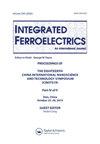Study on the Physical, Optical and Luminescence Properties of the Cr-Doped Recycled Waste Glass
IF 0.7
4区 工程技术
Q4 ENGINEERING, ELECTRICAL & ELECTRONIC
引用次数: 0
Abstract
AbstractThe rapid economic growth in recent years has led to the use of glass material in many activities, resulting in a large amount of glass waste. The efficient use of waste glass recycling has gained increasing attention. Researchers propose a method for recycling waste glass to reduce glass manufacturing costs and investigate the physical, optical, and luminescence properties of chromium oxide-doped glass with the stoichiometry of (35-x) B2O3: 35SiO2 (use waste glass as SiO2): 12Na2O: 7.9CaO: 0.1Sb2O3: 10BaO: xCr2O3 when x = 0.00 to 0.05 mol%. Glass was synthesized using the melt quenching at 1,200 degrees Celsius for 3 h. Archimedes’ principle and the Abbe refractometer were used to calculating density and refractive index decrease with the addition of 0.01 mol% of Cr3+ concentration. At room temperature, absorption spectra were analyzed using a UV-VIS-NIR spectrometer exhibiting two broadband at 438 and 625 nm intense bands, and the luminescence properties of the Cr3+ glasses system were investigated using an excitation wavelength of 567 nm, with luminescence peaks observed around 750 nm. CIE L* a* b* shows the green color.Keywords: Recycled waste glasschromium oxidephysical propertiesoptical propertiesluminescence properties Disclosure StatementNo potential conflict of interest was reported by the author(s).Additional informationFundingThe authors would like to thank under the project number N41A640252 This research project is supported by National Research Council of Thailand (NRCT), Thailand Science Research and Innovation (TSRI), The authors would like to thank the centre of Excellence in Glass Technology and Materials Science (CEGM), NPRU and Gemories Thailand Co., Ltd for providing the facilities.掺铬回收废玻璃的物理、光学和发光性能研究
摘要近年来经济的快速增长,导致许多活动中使用玻璃材料,造成了大量的玻璃废弃物。废旧玻璃的有效利用已越来越受到人们的重视。研究人员提出了一种回收废玻璃的方法,以降低玻璃的制造成本,并研究了化学计量量为(35-x) B2O3: 35SiO2(使用废玻璃作为SiO2): 12Na2O: 7.9CaO: 0.1Sb2O3: 10BaO: xCr2O3的氧化铬掺杂玻璃在x = 0.00至0.05 mol%时的物理、光学和发光性能。用阿基米德原理和Abbe折光计计算了在加入0.01 mol%的Cr3+浓度时玻璃的密度和折射率下降。在室温下,用紫外-可见-近红外光谱仪分析了Cr3+玻璃体系在438和625 nm两个波段的吸收光谱,并在567 nm激发波长下研究了Cr3+玻璃体系的发光特性,在750 nm附近观察到发光峰。CIE L* a* b*表示绿色。关键词:回收废玻璃氧化铬物理性质光学性质发光性质披露声明作者未发现潜在利益冲突。项目编号N41A640252本研究项目由泰国国家研究委员会(NRCT)、泰国科学研究与创新(TSRI)支持,作者要感谢玻璃技术与材料科学卓越中心(CEGM)、NPRU和Gemories泰国有限公司提供设施。
本文章由计算机程序翻译,如有差异,请以英文原文为准。
求助全文
约1分钟内获得全文
求助全文
来源期刊

Integrated Ferroelectrics
工程技术-工程:电子与电气
CiteScore
1.40
自引率
0.00%
发文量
179
审稿时长
3 months
期刊介绍:
Integrated Ferroelectrics provides an international, interdisciplinary forum for electronic engineers and physicists as well as process and systems engineers, ceramicists, and chemists who are involved in research, design, development, manufacturing and utilization of integrated ferroelectric devices. Such devices unite ferroelectric films and semiconductor integrated circuit chips. The result is a new family of electronic devices, which combine the unique nonvolatile memory, pyroelectric, piezoelectric, photorefractive, radiation-hard, acoustic and/or dielectric properties of ferroelectric materials with the dynamic memory, logic and/or amplification properties and miniaturization and low-cost advantages of semiconductor i.c. technology.
 求助内容:
求助内容: 应助结果提醒方式:
应助结果提醒方式:


